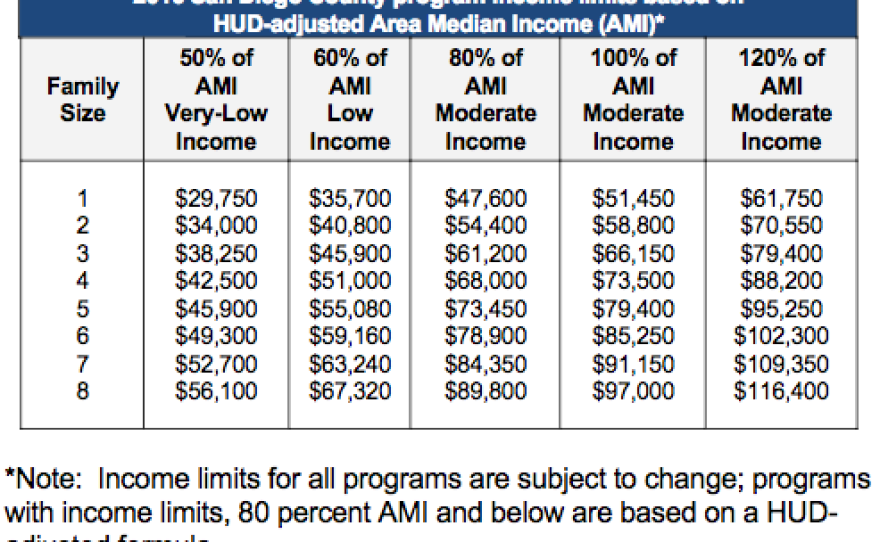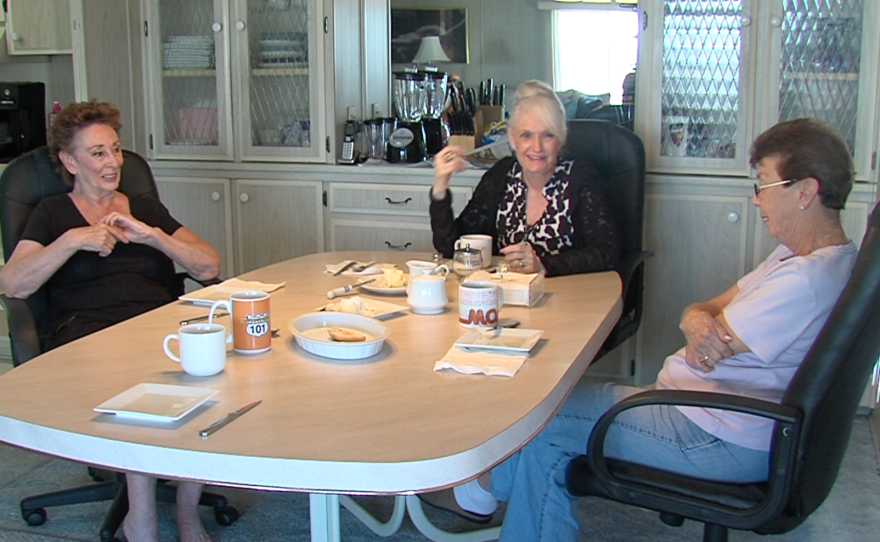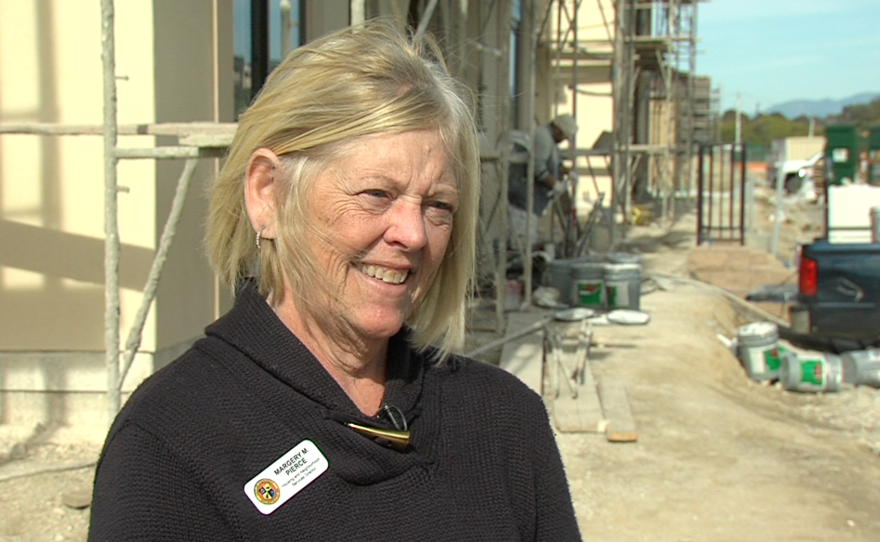The city of Oceanside will open a new affordable housing project later this year, the largest it has ever completed. But the city is losing affordable housing faster than it is building it.
Construction workers are busy hammering drywall on a three- and four-story apartment complex on Mission Avenue. When Mission Cove opens, the city will have 288 new affordable apartments to offer low-income families, seniors, veterans and foster youth.
Margery Pierce, the city’s Neighborhood Services director, said it has taken years to get to this point.
Oceanside will open and affordable housing projects this year and it is the largest ever. As Allison St. John discovered, the city is losing affordable housing faster than it is building it. Construction workers are climbing on apartments. Construction is finished, Oceanside will have new apartments for low-income families. There were some people that thought it would never happen. This is the service director. She says it is taking years to get the project off the ground. The city has not produced new affordable housing since 2013 but there are several projects works. We have a total of 358 units. They are in some process of construction and planning. This is a three bedroom two bath apartment for a family. It has a master with the en suite bathroom air. John is with the national core and they are building the machine code. They can be rented to families make Dan was bashed -- less than 60% of the median income. They have thermal water heating. The rent on a three bedroom such as this would be $500 to around $1100 per month. That is a fraction of the market rate rent. Seymour says the private investors contribute almost 2/3 of the first phase and they will get federal tax credits. The developer could not have done the job without the city. The city is our partner. They purchased the land and they are leasing it to the nonprofit developers and this will be 55+ year affordable housing. It is renovated in the 15th year and the 30th year and a 45th year and it will Rollo over. This timeline is important because as he explains, some of the early affordable housing was deed restricted as rentals for 10 to 15 years. They reverted back to market rate housing. I was not there at the time but if I had been, I would be kicking myself that back in the early days when we started these, we did not have the foresight to realize that we were going to need these units in perpetuity. Oceanside, like many cities is losing affordable housing faster than they are building it. Linda advocates for residents. There is a coffee party and she went over the concerns. The most important thing that we need to talk about is the fact that the land leases expiring in 2020. If the park is closing, they will have to give 12 months notice which puts us at 2019. My concern for you and your mom who was 94, what is going to happen when that happens when One area has closed and is being developed with townhomes. They estimate 6000 people live in the remaining mobile homes. Pierce questions that is the best use of valuable land. You will see redevelopment of the Lamb. If it is not within 10 or 20, somewhere down the line, I am sure. The government says the last regional housing needs assessment that by 2020, Oceanside needs to add more homes. But recent updates suggest they had 250 year homes than four years ago. That is even with the units they are adding this year. Literally, this place will lease up overnight. It is not going to take any effort of marketing whatsoever. The need is so great. People are watching this product -- project with excitement. Units go up and less easily to see homes that are losing ground. Allison St. John, K PBS news.
“It was a dream,” she said. “There were some people that thought it would never happen.”
Oceanside has not produced any new affordable housing since 2013, but Pierce said this year there are several projects in the works.
“We have a total of 358 units in the process of construction or planning right now,” she said.
John Seymour is with National Core, the non-profit developer building the first phase of Mission Cove. He showed us around a three-bedroom ground floor unit.
"These are built sustainable, universal design, solar thermal water heating,“ he said. “The rents on a three-bedroom such as this would be $500 to around $1,100 a month.”

That’s a fraction of the market rate rent of around $1,500 for even a small apartment in Oceanside. Because of the way this development is financed, it is deed restricted and can only be rented to people making less than 60 percent of the area median income.
Seymour said these affordable housing projects are a good investment. Private investors who contributed $27 million — almost two thirds of this $44 million project — will get the benefits of federal tax credits. And Seymour said, National Core and their partner developer, Community Housing Works, could not have done this project without financial help from the city of Oceanside.
“The city is our partner,” Seymour said. “They were the ones that purchased the land and they are ground leasing it to both non-profit developers. This will be 55-plus year affordable housing.”
This 55-year timeline is important because, as Pierce explained, some of the early affordable housing built in the 1980s and '90s was deed restricted as low income rentals for only 10 or 15 years. They have reverted back to market rate housing.
“We didn’t have the foresight to realize that we were going to need these units in perpetuity: that there was still going to be people in need of affordable housing,” Pierce said. “Now we’ve all been educated from experience to know that we really have to build projects kept affordable in perpetuity, that are going to be forever kept affordable.”
In fact, cities are losing affordable housing faster than they are building it.
Reporting misses net loss of affordable housing
To show if cities have met their goals of providing new affordable housing for low-income and medium income residents, the California Department of Housing requires an update of the housing plans every eight years.
RELATED: Nonprofit Developers Strive To Preserve Affordable Housing
But Evan Gerberding of the state Housing Department said they don’t have to keep track of how much they have lost.
“From the state’s perspective, it is critical to add new housing supply to accommodate new population growth as well as ensure the affordability and habitability of existing housing stock,” she wrote. “However, current housing element law does not require jurisdictions to report how many affordable units were lost, unless it is in a coastal zone, though many jurisdictions do identify that information as part of their analysis.”
Oceanside is not the only city losing ground in its affordable housing goals. But it does have one type of housing that is particularly vulnerable to the increasing value of land along the coast.
Oceanside — Mecca for mobile home parks
Oceanside has long had a reputation for being one of the more affordable places to live in North County. One reason is because of the large number of mobile home parks. An estimated 6,000 people live in them.
Linda Sills lives in Mission View West, one of the city’s 17 parks, along with her 94-year-old mother. Sills said her parents moved in when they retired.

“They bought this home for $33,000 in 1985,” she said. “It was built, I believe, in 1968.”
The home is holding up, but like many older mobile homes, couldn’t be moved if the park owner sold the land beneath it.
Sills, who is retired and living on a fixed income, sometimes gets together for coffee with other residents who are also worried about their future.
“I think the most important thing we need to talk about is the fact that the land lease is expiring in 2020,” said Linda Walshaw, another mobile home park resident and advocate for residents at the city. “If the park is closing, he’ll have to give 12 months notice, which puts us at 2019: in two years. And my concern for you and your mom — who is 94 — what is going to happen when that happens?”
Walshaw said studies show almost 5,000 mobile homes spaces around California have disappeared in the last decade.
The Catalina mobile home park in Oceanside, five blocks from the beach, closed in 2009. Heavy equipment is now preparing the site for new town homes.
Walshaw estimated about 2,500 mobile home spaces remain in parks around Oceanside. She said the city should start thinking ahead about what will happen to residents if the parks close.
Neighborhood Services Director Pierce questioned whether mobile home parks are the highest and best use of the land.
“Is there a risk that mobile home parks are going to close?” she asked. “Yes, certainly with the limited land — they are sizable, the land is expensive — it has a value. We’re going to see redevelopment of that land: if it’s not within 10 years, 20, 30, somewhere down the line, I’m sure.”
Pierce said she does not know if people who have bought into mobile home parks are low income, because there is no deed restriction requiring park owners to rent only to those with low incomes. But she acknowledged mobile homes are more affordable than most market rate housing.
“We’re going to have to just be creative and meet those challenges as they come forward,” she said. “When, and if a mobile park home park moves to closing, there’s benefits in terms of relocation and rental assistance. And then we need to continue to find places like Mission Cove so they have places that they can afford.“
But Oceanside, like many cities around the region, is seeing a net loss of affordable places to live. For example, in the last decade, the city of San Diego has lost thousands of SROs — single room occupancy hotels — where seniors and those on fixed incomes could find a place they could afford.
Losing ground on low-income housing
The San Diego Association of Governments, or SANDAG, estimated in its last Regional Housing Needs Assessment Plan that, between 2010 and 2020, Oceanside needs to add 2,700 more homes for low-income families to meet demand.
Pierce said this year the city has 1,379 affordable housing units.
SANDAG’s most recent Regional Housing Progress Report shows that in 2013 the city had an estimated 1,637 affordable units.
So even including the 358 units of affordable housing Oceanside is adding this year, the city still has about 250 fewer affordable homes than it had about four years ago.

Pierce said she is committed to continuing the effort to fill the gap between the amount of affordable housing and the number of people who need it.
“It’s an investment in our residents and in our workforce to provide affordable housing, so that people that work, live and play here have a place to stay,” she said. “The city has to help and step up to the plate and fill that gap.”
But she knows Mission Cove is a drop in the bucket of need for more affordable housing
“I can tell you, this place will lease up overnight,” she said. "It’s not going to take any effort of marketing whatsoever, the need is so great. People are watching this project with excitement.”
It’s easier to see new affordable housing going up than it is to see affordable housing draining away, as older housing that was once affordable disappears.







